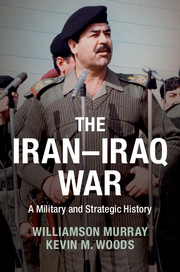Book contents
- Frontmatter
- Dedication
- Contents
- List of figures
- List of tables
- Preface
- Acknowledgments
- Note to reader
- 1 Introduction
- 2 A context of “bitterness and anger”1
- 3 The opponents
- 4 1980: The Iraqi invasion begins
- 5 1981–1982: Stalemate
- 6 Defeat and recovery
- 7 1983–1984: A war of attrition
- 8 1985–1986: Dog days of a long war
- 9 1987–1988: An end in sight?
- 10 Conclusion
- Appendix A Timeline
- Appendix B People
- Appendix C Place names
- Appendix D Order of battle
- Bibliography
- Index
- References
7 - 1983–1984: A war of attrition
Published online by Cambridge University Press: 05 September 2014
- Frontmatter
- Dedication
- Contents
- List of figures
- List of tables
- Preface
- Acknowledgments
- Note to reader
- 1 Introduction
- 2 A context of “bitterness and anger”1
- 3 The opponents
- 4 1980: The Iraqi invasion begins
- 5 1981–1982: Stalemate
- 6 Defeat and recovery
- 7 1983–1984: A war of attrition
- 8 1985–1986: Dog days of a long war
- 9 1987–1988: An end in sight?
- 10 Conclusion
- Appendix A Timeline
- Appendix B People
- Appendix C Place names
- Appendix D Order of battle
- Bibliography
- Index
- References
Summary
My brothers, as long as our army has strong morale and has an ability to wage an attack there is no fear, even if the enemy [is] able to occupy some of our lands, as long as we are strong we can [regain] these lands, now, a year from now, or two years from now. [However,] if we lose our morale and our ability to wage an attack then we could lose the whole of Iraq.
– Saddam HusseinAs early as fall 1981, Saddam had ordered his army commanders to begin preparing defenses in case Iran invaded. During the next several years, the Iraqis constructed extensive field fortifications, especially in the south, to defend their territory. Meanwhile, with Khomeini’s blanket refusal to consider peace, the Iraqis massively expanded the army. At the war’s outset, the army was approximately 200,000 soldiers in thirteen divisions and three brigades. By early 1983, the expansion was well on the way to reaching what it would reach by late 1984, nearly half a million men in twenty-three divisions with nine additional brigades.
The sources of equipment and weapons for the expanding army and air force were diverse. Once again in 1982, the Soviets refused to contract for increased deliveries of weapons and spare parts; however, Soviet attempts to remain “neutral” were quickly overcome by the pressure to maintain their standing with the Arabs and the cold reception they received from the Iranians. In early 1983, Iraq finally concluded a set of amendments to arms contracts with Moscow worth $230 million to build a rocket manufacture facility and aircraft repair depot, and to provide “certain special military equipment.”
- Type
- Chapter
- Information
- The Iran–Iraq WarA Military and Strategic History, pp. 205 - 240Publisher: Cambridge University PressPrint publication year: 2014



